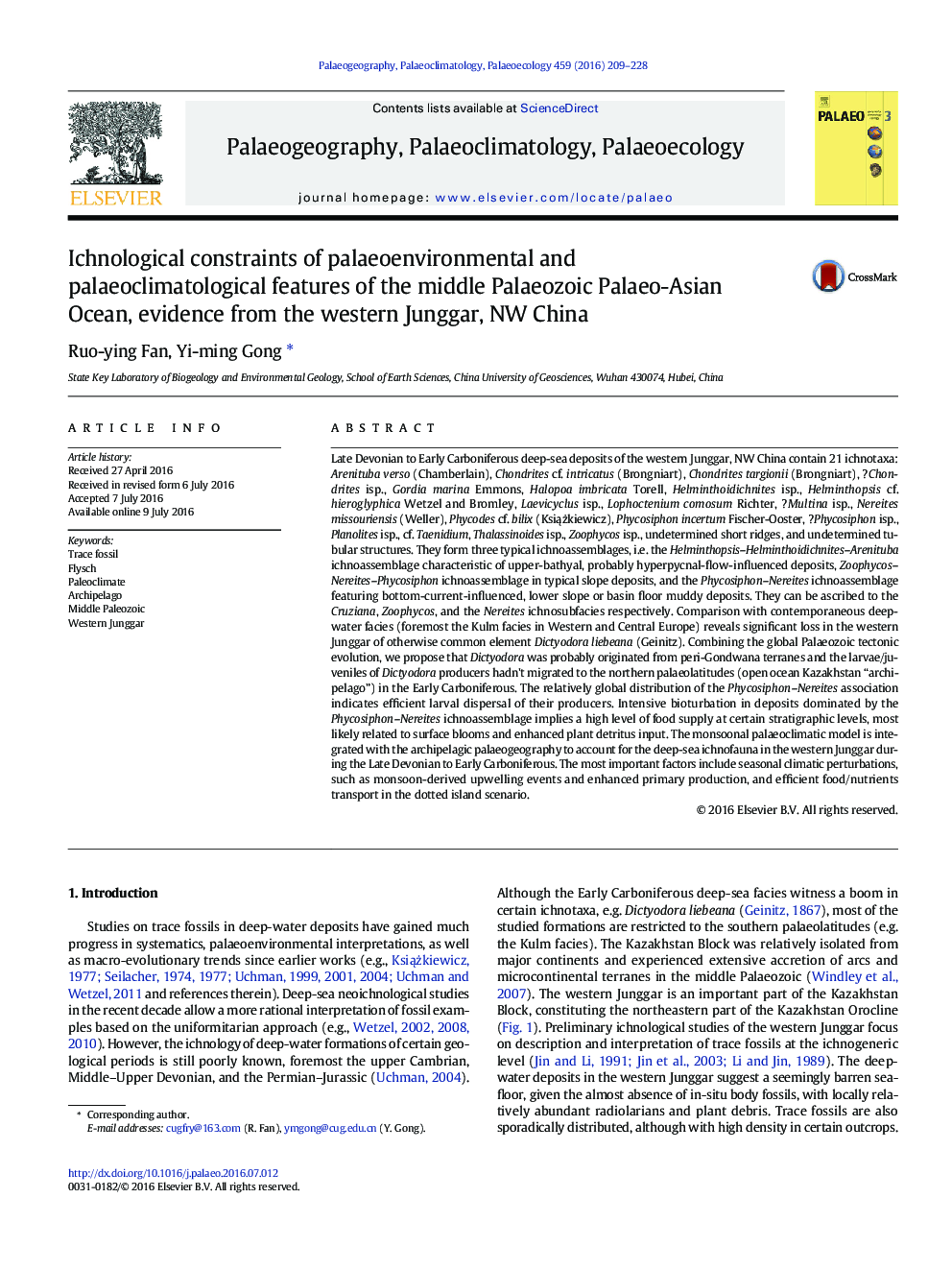| کد مقاله | کد نشریه | سال انتشار | مقاله انگلیسی | نسخه تمام متن |
|---|---|---|---|---|
| 4465633 | 1622132 | 2016 | 20 صفحه PDF | دانلود رایگان |

• Twenty-one deep-sea trace fossils were described from the western Junggar, Xinjiang.
• Three ichnoassemblages belong to the Cruziana, Zoophycos, and Nereites ichnosubfacies.
• Abundant large Phycosiphon and Nereites reflect high level of benthic food contents.
• The monsoonal climate and archipelagic geography control the deep-sea ichnofauna.
Late Devonian to Early Carboniferous deep-sea deposits of the western Junggar, NW China contain 21 ichnotaxa: Arenituba verso (Chamberlain), Chondrites cf. intricatus (Brongniart), Chondrites targionii (Brongniart), ?Chondrites isp., Gordia marina Emmons, Halopoa imbricata Torell, Helminthoidichnites isp., Helminthopsis cf. hieroglyphica Wetzel and Bromley, Laevicyclus isp., Lophoctenium comosum Richter, ?Multina isp., Nereites missouriensis (Weller), Phycodes cf. bilix (Książkiewicz), Phycosiphon incertum Fischer-Ooster, ?Phycosiphon isp., Planolites isp., cf. Taenidium, Thalassinoides isp., Zoophycos isp., undetermined short ridges, and undetermined tubular structures. They form three typical ichnoassemblages, i.e. the Helminthopsis–Helminthoidichnites–Arenituba ichnoassemblage characteristic of upper-bathyal, probably hyperpycnal-flow-influenced deposits, Zoophycos–Nereites–Phycosiphon ichnoassemblage in typical slope deposits, and the Phycosiphon–Nereites ichnoassemblage featuring bottom-current-influenced, lower slope or basin floor muddy deposits. They can be ascribed to the Cruziana, Zoophycos, and the Nereites ichnosubfacies respectively. Comparison with contemporaneous deep-water facies (foremost the Kulm facies in Western and Central Europe) reveals significant loss in the western Junggar of otherwise common element Dictyodora liebeana (Geinitz). Combining the global Palaeozoic tectonic evolution, we propose that Dictyodora was probably originated from peri-Gondwana terranes and the larvae/juveniles of Dictyodora producers hadn't migrated to the northern palaeolatitudes (open ocean Kazakhstan “archipelago”) in the Early Carboniferous. The relatively global distribution of the Phycosiphon–Nereites association indicates efficient larval dispersal of their producers. Intensive bioturbation in deposits dominated by the Phycosiphon–Nereites ichnoassemblage implies a high level of food supply at certain stratigraphic levels, most likely related to surface blooms and enhanced plant detritus input. The monsoonal palaeoclimatic model is integrated with the archipelagic palaeogeography to account for the deep-sea ichnofauna in the western Junggar during the Late Devonian to Early Carboniferous. The most important factors include seasonal climatic perturbations, such as monsoon-derived upwelling events and enhanced primary production, and efficient food/nutrients transport in the dotted island scenario.
Journal: Palaeogeography, Palaeoclimatology, Palaeoecology - Volume 459, 1 October 2016, Pages 209–228